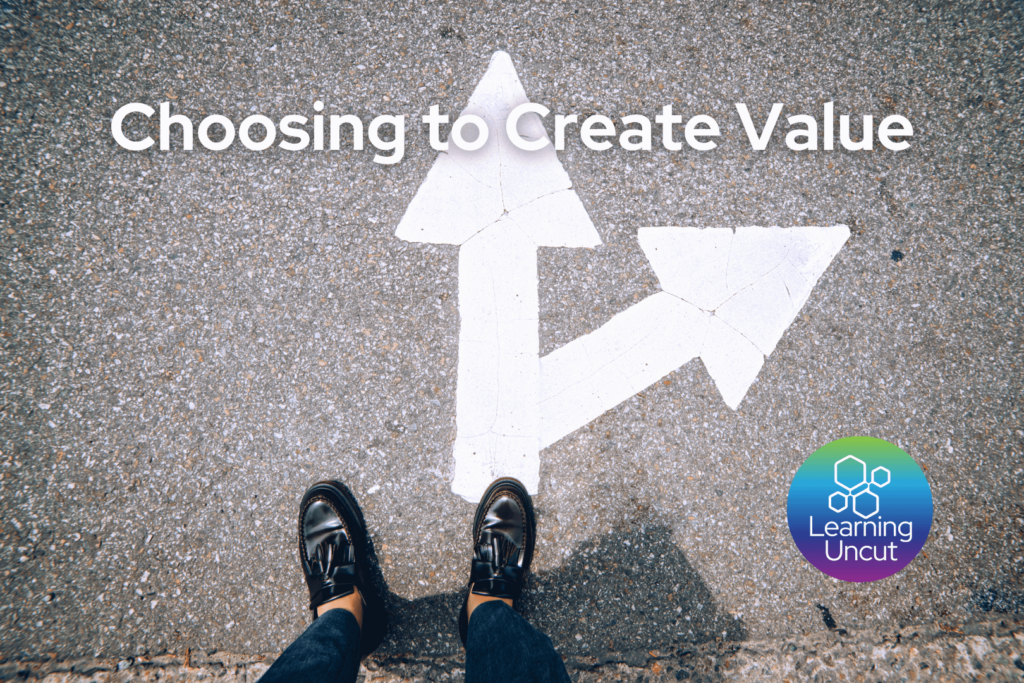The Unfinished Business of L&D’s Value
Every year, Donald H. Taylor’s Global Sentiment Survey asks thousands of L&D professionals what’s on their minds. And every year, the response includes some version of the same concern:
- How do we prove L&D’s value?
- How do we get the business to take us seriously?
- How do we demonstrate our impact?
This conversation never seems to end. In fact, the 2025 Global Sentiment Survey1 shows a renewed focus on what Don calls the ‘value trio’ – Consulting more deeply with the business, Showing value, and Performance support. It seems that as AI reshapes L&D, professionals are recognising that their ability to create value is more critical than ever.
But here’s the problem: we’ve been having this conversation for years.
It’s not that L&D doesn’t genuinely care about value – we do. It’s not that we don’t know how to create value – there’s plenty of advice out there. But knowing isn’t the same as doing.
I’ve recently re-read Seth Godin’s excellent book Linchpin, in which he makes the following point clear:
The most indispensable people are the ones who choose to create value – again and again.
Creating value isn’t about job titles, resources, permission or a seat at the table. It’s a choice – and making that choice requires what Godin calls emotional labour.
If L&D wants to be indispensable, we need to stop waiting for our value to be recognised by others and start choosing to create value every single day.
How We Typically Think About Creating Value
Ask most L&D professionals how to ‘create value’ and you’ll hear things like:
- Speak the language of business
- Align with organisational goals
- Measure learning impact
This advice isn’t wrong (and it’s advice I’ve often given others). However, it omits a critical first step.
Before we can measure value, before we can prove value, before we can create value… we have to choose to do it. And we have to keep choosing it, even when it’s hard, even when no one else sees it yet, even when it would be easier to just go with the flow.
That’s where emotional labour comes in. Emotional labour is hard work:
- Challenging assumptions
- Having difficult conversations
- Navigating resistance
- Not having all the answers
- Taking action in the face of uncertainty
This is the work that L&D professionals and teams that drive impact don’t shy away from. They embrace the discomfort, knowing that this is a necessary part of making the meaningful difference that drives so many of us in this big-hearted profession.
Take Hayley Curcio, for example.2 In April 2021 Hayley joined 99designs as their first-ever L&D Leader. She walked into a business that already had a strong culture of informal learning, but no structured L&D strategy or programs. Rather than waiting to build something behind the scenes, she took immediate action.
Within weeks of starting, she launched a leadership development program. Rather than design designing a polished curriculum before launch, she co-created this program in real time with the participants. Every week she gathered feedback, adjusted the content and activities, and adapted based on what the participants needed.
It was a risk. She had no guarantee that leadership would support an experimental approach. She had to listen, earn trust, and adapt constantly. But because she chose to act, rather than wait for certainty, she was able to deliver a program that had an immediate, meaningful impact.
That’s one example of what choosing to create value looks like.
What Holds Us Back? The ‘If Only’ Exercise
If choosing to create value is so important, why don’t more L&D professionals do it?
Seth Godin offers a simple way to reveal the real barriers:
“I could create more value if only…”
Try it for yourself. Fill in the blank:
- If only I had more budget.
- If only my stakeholders took L&D seriously.
- If only I had more time.
- If only our organisation embraced learning culture.
These statements feel real. But are they actually stopping you? Or are they just excuses, things you could work around or move forward in spite of – if you could muster the courage, persistence, resilience or support network needed to do the emotional labour?
Take ‘Natalie’ (real story, name changed). When she stepped into her role as an L&D leader in a regional business function in a med tech company, L&D was seen as just a training function. Her stakeholders measured success by how many courses were delivered, not by whether those courses (or any other type of learning solution) had any impact. (Sound familiar?)
She could have said: “I could create more value if only my leaders saw L&D differently.” Instead, she chose to shift that perception.
She started with a simple but powerful change: encouraging leaders to take more accountability for learning. She introduced a process where managers were expected to follow up with their teams about how they were applying what they’d learned.
Not everyone was on board. Some leaders resisted, seeing this as extra work rather than an essential part of performance improvement. Natalie had to have tough, persistent conversations to get them to step up and to see the part they played as a partner with L&D to change behaviour and drive business outcomes.
She stuck with it. Over time, as managers saw real improvements in how their teams applied learning on the job, resistance turned into support. Eventually, L&D was no longer seen as a place to order training – it became embedded in how the business operated.
Natalie didn’t wait for leadership to change their mindset and see L&D differently. She chose to create value by pushing through resistance and making it happen.
Breaking Through: How to Keep Choosing Value
Instead of saying, “If only…”, ask yourself:
What can I do right now?
Choosing to create value means doing emotional labour. In L&D that looks like:
- Having difficult conversations – Pushing back on ‘just build a course” requests, influencing stakeholders, and standing firm in uncomfortable moments.
- Challenging the status quo – Questioning legacy practices, calling out and exploring outdated assumptions, and finding champions to advocate for change alongside you.
- Taking risks without certainty – Acting before everything is perfectly planned, just like Hayley did. Experimenting, testing approaches, being prepared to ‘fail’ in order to learn.
- Being relentless – Natalie didn’t change perceptions overnight. It took persistence, patience and courage. Find your north start and keep moving towards it, one step at a time.
What’s your “If only…” excuse? And what’s one step you can take today to move past it?
Will You Choose to Create Value?
Most L&D professionals say they want to create value. But wanting isn’t enough. Knowing how isn’t enough. The ones who choose to create value – and keep making that choice – become indispensable.
Because in the end, creating value isn’t a business decision – it’s a personal one.
[1] To explore the GSS 2025 download the Global Sentiment Survey 2025 Report and/or listen to Michelle Ockers and Donald H Taylor discuss key insights from the report in Learning Uncut Elevate 41 L&D Global Sentiment 2025 [2] This story is taken from Learning Uncut Emergent 23: Taking Bold Action – Hayley Curcio


